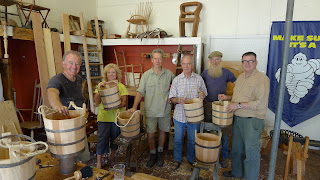I then got stuck into final shaping of the crested rocker parts, before glueing it up. There were just a few small parts that I had to make to finish the job. Ten tapered wedges for the legs, arms and stiles, in various widths and lengths and two long 10mm Pin Oak dowels. These dowels are the loose tenons that join the carved arm paddles to the stiles and are then wedged from the back of the stile. For this reason they have to be a precise fit.
Too loose and obviously they will not provide much structural strength, too tight they won't fit or worse still will bind up half way through gluing or worse again they might split what they are being driven into.
Despite knowing of tenon cutters and indeed using one to cut the dowels for the Crested Rocker I made with Pete Galbert in his workshop, I usually end up just turning them on the lathe to size. This can be a little fiddly, given the size.
Well today I finally got off my behind and made a 10mm tenon cutter. Following on from my 'keep it simple' process on my last shave horse, I grabbed a lump of redgum from the scrap bin, drilled a 10mm hole, tapered the in-feed side slightly and cut out a wedge large enough to accept a spokeshave blade at a reasonable angle. I then drilled and tapped a threaded insert into the wood and 'borrowed' a nice Hock blade from one of my spokeshaves to test it out. I'll fit a permanent blade later with a curved edge leading into the throat of the cutter.
A stick of Pin Oak roughly rounded at one end and with the edges broken was then chucked into my cordless drill. Then, put square peg into round hole.........at speed!
And here's the result.
One 10mm dowel in less than ten seconds. How was the sizing? You'll need to turn up the volume.....
Like a bum in a bucket! Should have made one of these things years ago.






































